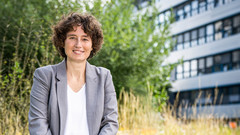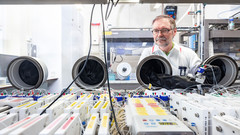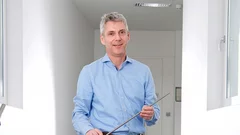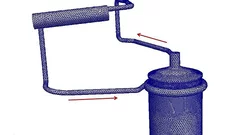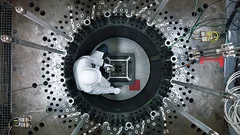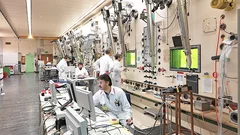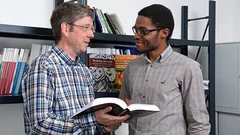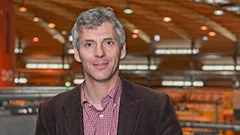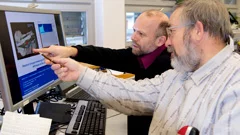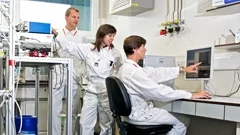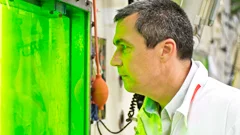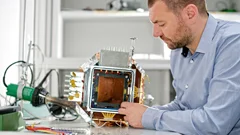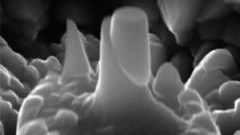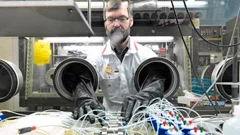Nuclear energy
The best of both worlds
Annalisa Manera works as a nuclear researcher at PSI and as a professor at ETH Zurich. A portrait.
Safely stored for a million years
Switzerland plans to construct a deep repository for its radioactive waste. There are three potential locations, and data obtained by PSI researchers can aid in selection of the best one.
Modelling and simulation pay off
Researchers in PSI's Laboratory for Scientific Computing and Modelling solve the most complex problems through a combination of theory, modelling, and high-performance computing. With powerful computers, they simulate the smallest molecules or large research facilities.
Cladding tubes and their properties
In the Nuclear Energy and Safety Research Division at PSI, Johannes Bertsch focuses on the so-called cladding tubes that are used in nuclear power plants.
Simulations for More Efficient Power Stations
In most cases, electricity is generated when water is heated and transformed into vapour. Vapour bubbles in the water play a decisive role in this process. Using computer simulation, researchers at the Paul Scherrer Institute have succeeded in representing the behaviour of vapour bubbles – and in making their performance more calculable.
Molten salt reactors – exploring an alternative
At the Paul Scherrer Institute PSI, a small group of scientists is using theoretical models to explore an alternative for future nuclear reactors: so-called molten salt reactors. This helps to secure Switzerland’s expertise regarding globally relevant questions in the area of nuclear energy and reactor safety, for today and tomorrow.
Decommissioning of the research reactor Proteus
Start of the public examination period for decommissioning of the nuclear facility Proteus at the Paul Scherrer Institute PSIThe nuclear research facility Proteus is a so-called zero-power reactor. In service, the thermal output of the reactor was limited to a maximum of 1 kW. That means this is an experimental reactor that was run at a power level so low that it did not require cooling. Proteus went into service in 1968. The PSI would like to decommission the facility. The decommissioning project is now being publicly announced in the legally prescribed, official publications.
The hotlab research facility
Start of the public examination period for renewed authorization to operate the research facility hotlab at the Paul Scherrer Institute PSIThe hotlab at the Paul Scherrer Institute PSI is a facility, unique in Switzerland, where researchers study highly radioactive materials in specially shielded chambers called hot cells. It serves the needs of applied materials research on highly radioactive samples from core structural components and fuel rods from nuclear power plants, research reactors, and the PSI radiation facilities. Through its operation of the hotlab, the Paul Scherrer Institute also contributes to the safety of the nuclear power plants in Switzerland. Around thirty staff members attend to the hotlab's safety technology and analysis infrastructure.
More robust thanks to imperfections
Microscopic deviations from the ideal structure render uranium dioxide, the fuel commonly used in nuclear power plants, more resistant to radiation damage.
Hydrogen: a Trojan horse in fuel-rod cladding tubes
In nuclear reactors, water is dissociated at the surface of the hot fuel elements, thereby producing hydrogen. This hydrogen can penetrate the fuel cladding surrounding the actual fuel and weaken it mechanically. Researchers from the Paul Scherrer Institute (PSI) have been using neutrons and synchrotron radiation to study how the hydrogen gets into the cladding tube and what impact it can have once inside.
How rock pores in deep repositories close over
Chemical reactions will change the nature of the deep repository and the surrounding rock (clay rock); that much is certain. But to what extent and with what impact on safety? Researchers from the Paul Scherrer Institute are looking to answer this question with the aid of a combination of experiments and computer simulations.
Computer simulations: a cornerstone of nuclear power station safety
Without computer simulations, the operation of nuclear power stations would be very difficult. Whether it is a question of installing new components or conducting safety tests, virtually everything has to be calculated and analysed on the computer first. At the Laboratory for Reactor Physics and Systems Behaviour of the Paul Scherrer Institute PSI, computational models and methodologies are developed with precisely this in mind. Through this, PSI researchers also act as an independent partner to the national regulatory authority ENSI and contribute thereby to support safe operation of the Swiss nuclear power plants.
Well-rounded concept for less nuclear waste
The idea of producing fuel for nuclear power stations in form of a package of spheres instead of today’s customary pellets was already born back in the 1960s. There was promise of a subsequent simplification of fuel production and a considerable reduction in the amount of radioactive waste both in the production of the fuel itself and after its use in a nuclear power station. However, the spherical fuel was never implemented as the fast reactors for which it was conceived were never built at a large scale. The Paul Scherrer Institute (PSI) has also been involved in the research on spherical fuel in the past. Now several projects partly funded by the EU are currently underway at the PSI again to refine the production of fuel spheres further. This form of fuel could either be used in special plants to reduce waste or in fast generation IV reactors, which in a closed cycle also produce less long-lived waste.
Reconstruction of the Fukushima nuclear accident
Researchers at the Paul Scherrer Institute (PSI) are currently involved in an international project aimed at reconstructing what happened to the reactor units during the nuclear accident at the Japanese nuclear power station, Fukushima Daiichi in March 2011. In particular, the estimate of the core end-state will help the owner of the damaged plant, the Tokyo Electricity Power Company (TEPCO) to plan the removal of components from the reactor containment and the final decontamination. Besides, the exercise is intended to contribute to further refinement of the computer programs used to perform nuclear accident simulations
Knowledge for tomorrow from "hot cells"
The manipulation and examination of irradiated and therefore radioactive objects, be they from nuclear power stations or research facilities, requires strict safety measures. Tests may only be conducted in so-called hot cells, where the radioactivity is hermetically enclosed and shielded behind concrete and lead walls up to 1 metre thick. In the hot cells of the PSI hot lab, the burnt-off fuel rods from the Swiss nuclear power stations are studied from a materials science perspective. The insights gained help nuclear power station operators to optimise the efficiency and safety of their plants. Besides this service, the hot lab is involved in several international research projects.
Fast neutrons for improved safety
Neutrons are an excellent tool for the non-destructive imaging the interior of objects. They can provide a valuable complement to the more widely used x ray radiography. For some materials that are virtually opaque or for those that cannot be distinguished by X-rays, neutrons provide the only informative dissection tool. However, neutron radiography is mainly confined to the laboratory and fixed facilities, because neutron generation relies on equipment like nuclear reactors or particle accelerators, which are costly, complex and cannot be moved. Scientists at the Laboratory for Thermohydraulics at the Paul Scherrer Institute PSI want to develop a more flexible imaging technique based on fast neutrons.
Retention of radioactive iodine in serious NPP accidents
Researchers at the Paul Scherrer Institute [PSI] have developed a highly efficient technique for filtering radioactive iodine. It removes virtually all of the iodine from radioactively contaminated exhaust air before its release into the environment after a meltdown at a damaged nuclear power plant. The process has recently become ready for worldwide use at nuclear power installations, after PSI and the industrial company CCI AG (Balterswil/TG) have signed a licensing agreement for the PSI patented process.
Reliable materials for nuclear reactors
Materials used in nuclear power plants are subjected to extreme conditions. The safety standards for the selection, deployment and monitoring of these materials are extremely high. At PSI, the long-term behaviour of power plant components is being studied. Hence researchers investigate the impact of stress-corrosion cracking in materials, or the effects of strong radioactive radiation on their durability.
Safe repositories for radioactive waste - a study of specifically Swiss conditions
Radioactive waste from nuclear power plants, as well as from medical applications, industry and research, has to be isolated from the environment, particularly the habitat of humans, for a very long time. Specialists at PSI have been concerned with the safety issues surrounding safety certification for geological repositories for many years. Research at PSI focusses primarily on the physico-chemical processes inside such storage systems. The aim is to create a realistic description of the risks associated with storage of radioactive waste.
